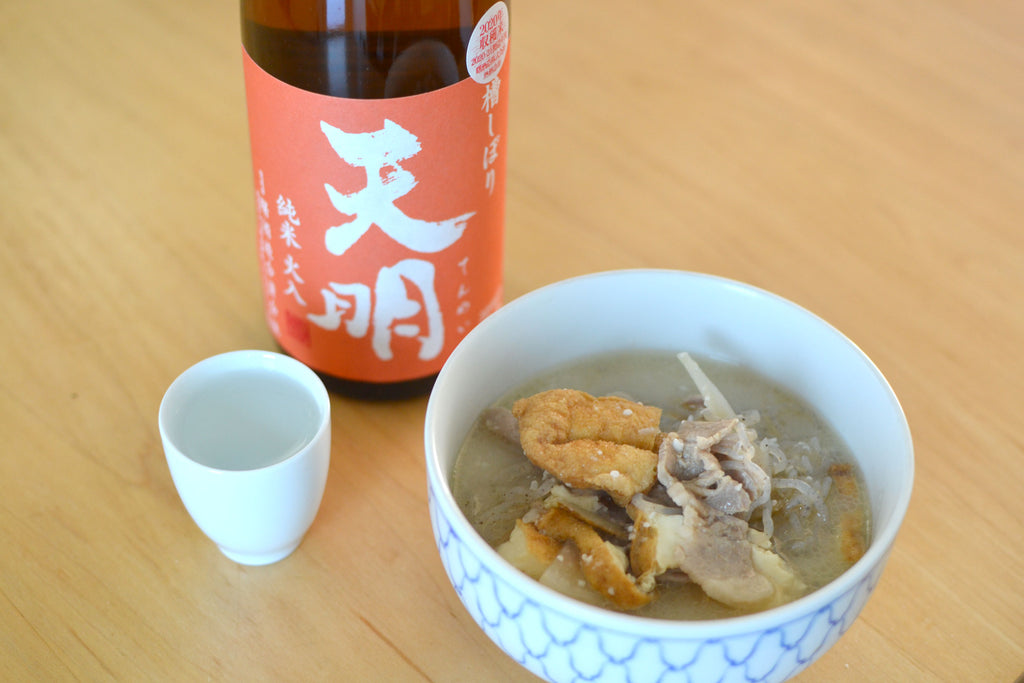Winter Food Traditions (December 2021)
 Sake Gumi is our monthly sake subscription service with 250 members throughout the country. Join today!
Sake Gumi is our monthly sake subscription service with 250 members throughout the country. Join today!
As the bears start getting ready for hibernation, the bees hunker down in their hives to stock up on their stored honey, we start hanging up our hoshigaki and fire up our ovens. All animals have their winter traditions that remind us to rest, reconnect, and most importantly, fatten up on brumal food and drink! That's why this month, I am introducing cozy recipes that incorporate Japanese winter foods for Sake Gumi members.
Sake is a wintertime beverage itself. Because rice is harvested in the fall, sake-making is in full swing by December, and the first, fresh-pressed sakes are released as winter solstice approaches. When these sakes are released, breweries replace the cedar balls that hang outside their doors with new ones, signaling that sake is ready. Sake is also traditionally enjoyed warm, making it the perfect wintry drink.
In addition to making sake, I asked the brewers from this month's Sake Gumi about their own winter traditions. Tonoike Shuzo in Tochigi shared that they partake in a "Sake Kasu Tsumehoudai'' competition, where contestants try to make the heaviest mound of sake kasu. Meanwhile in Aizu Bange in Fukushima, where Akebono Shuzo resides, the townspeople participate in a tug-of-war involving a large bale weighing five tons. If the team on the east side wins, it predicts that the price of rice will rise, while if the west side wins, it signals a good harvest.
Although we can not visit Japan again this year to join in on these festivities, the next best thing is to celebrate them from afar with recipes that are prevalent in Japan during the winter. Shata Shuzo lets us in on one of the best pairings this month with their sake – Hoshigaki Cream Cheese Roll.

I also can't wait to share the Sake Kasu Tonjiru pairing with the Tenmei Junmai.

Please visit our blog for these recipes!
I hope that you all will enjoy one or all of these pairings alongside your own winter traditions this December.
Yoko, Co-Founder of Umami Mart and Kikizakeshi
 Tengumai Comon Tokubetsu Junmai
Tengumai Comon Tokubetsu Junmai
Shata Shuzo (Ishikawa, Japan)
Seimaibuai: 60% Yamada Nishiki, SMV: +3, Acidity 1.6
We started our own winter tradition at Umami Mart this year: hoshigaki. And that’s perfect because Hirohisa Ogawa of Shata Shuzo says that hoshigaki and cream cheese is an ideal pairing with this sake. We made this dish by slicing a hoshigaki lengthwise and stuffing it with cream cheese and walnuts. Then we chilled it in the fridge and cut it in slices. Get the full recipe here! Warm this sake up and enjoy it in a guinomi (ceramic cup). The warmth highlights aromas of cedar, muscat grapes, and steamed rice.
 Rolling the Hoshigaki, cream cheese, and walnuts together.
Rolling the Hoshigaki, cream cheese, and walnuts together.
 Fukuju Blue Junmai Ginjo
Fukuju Blue Junmai Ginjo
Kobe Shushinkan (Kinki, Japan)
Seimaibuai: 60% Hyogo Yume Nishiki, SMV +2, Acidity 1.3
This layered sake, with aromas of yellow peach and flavors of roasted sweet potato, features a long finish full of umami. It also has a lavish, buttery texture that is a great pairing with oysters. Kubota-san, the Vice President of Shushinkan, specifically recommends oyster gratin, so we had this sake chilled alongside Camino’s recipe: Baked Oysters With Absinthe and Breadcrumbs. We’ll survive on this all winter!
 Kubota-san also added this sake pairs with pumpkin tart. Fun fact: Calligrapher Tansetsu Ogino designer of Suntory’s Hibiki Whisky label also designed this label.
Kubota-san also added this sake pairs with pumpkin tart. Fun fact: Calligrapher Tansetsu Ogino designer of Suntory’s Hibiki Whisky label also designed this label.
 Bo: Junmai Ginjo Muroka Nama Genshu
Bo: Junmai Ginjo Muroka Nama Genshu
Tonoike Shuzo (Tochigi, Japan)
Seimaibuai: 53% Hitogokochi, SMV + Acidity undisclosed
The folks at Tonoike Shuzo recommend a very simple Sashimi and Daikon Carpaccio recipe to pair alongside this bright sake. Slice sashimi grade fish and daikon into thin slices and sprinkle with olive oil and lemon juice to complete! Get the recipe here!
 This dish perfectly complements the aromas of grapefruit and yuzu, while providing enough richness to contrast the white-wine like acidity of this sake. Enjoy this slightly effervescent sake chilled or at room temperature in a wine glass. For vegetarians, try this sake with camembert cheese!
This dish perfectly complements the aromas of grapefruit and yuzu, while providing enough richness to contrast the white-wine like acidity of this sake. Enjoy this slightly effervescent sake chilled or at room temperature in a wine glass. For vegetarians, try this sake with camembert cheese!
 Tenmei Junmai Funashibori Hiire
Tenmei Junmai Funashibori Hiire
Akebono Shuzo (Fukushima, Japan)
Seimaibuai: 50% Yamada Nishiki, SMV 0, Acidity: 1.4
This sake is unique in that it uses four types of rice: Yamada Nishiki, Gohyakumangoku, Kameno Oo, and Yume no Kaori, resulting in a very complex flavor kaleidescope. Balancing umami, acidity, and sweetness, this sake is very versatile for food pairing. However, our favorite winter food pairing was having this sake warm in a guinomi with Sake Kasu Tonjiru. Note the sticker on the bottle that states this 2021 release uses rice harvested in 2020.

